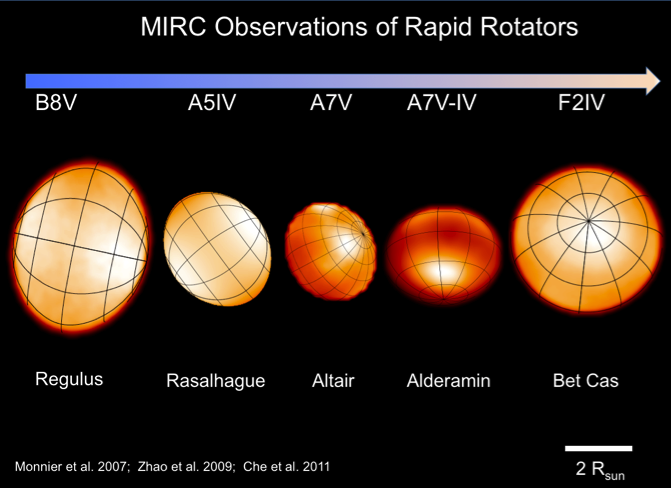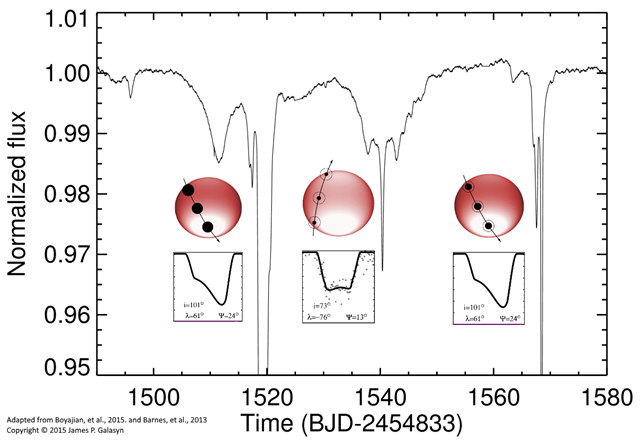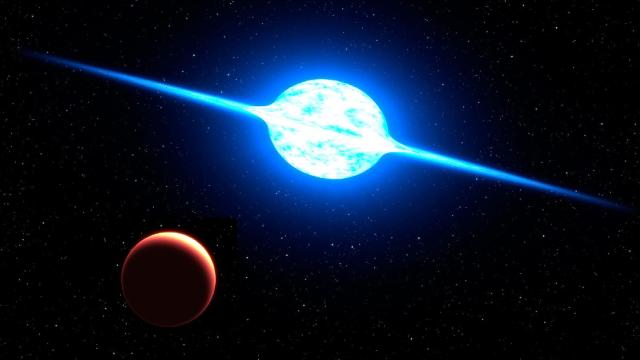The Kepler Space Telescope recently picked up unprecedented flickering behaviour from a distant star, leading to speculation that — among other things — it might be an alien megastructure. Now, some astronomers are saying it might just be caused by a rapidly spinning and irregularly shaped star.
Star KIC 8462852 — recently dubbed “Tabby’s Star” — is emitting a transit signature that defies explanation. Normally, the luminosity of a star drops at a consistent rate when an alien planet passes in front, but not Tabby’s star. This object is dimming at irregular intervals and at levels that far exceed anything seen before.
Kepler astronomer Tabetha Boyajian and her colleagues suggest that this could the remnants of a planetary collision, or maybe a massive cometary cloud. More radically, Penn State astronomer Jason Wright and his colleagues have speculated that it might be an alien megastructure, like a Dyson Sphere. But even Wright admits this is a “perilous approach to science” — one that could lead to an “alien in the gaps” fallacy, and unfalsifiable hypotheses.
A number of other theories have been tossed about, but there’s one in particular that’s starting to attract some attention. It’s the phenomenon of gravity darkening and spin-orbit misalignment.

Paul Gilster from Centauri Dreams explains:
In this scenario, we have a star that is spinning fast enough to become oblate; i.e., it has a larger radius at the equator than it does at the poles, producing higher temperatures and ‘brightening’ at the poles, while the equator is consequently darkened. The transits of a planet in this scenario can produce asymmetrical light curves, a process the Wright paper notes, and one that [astronomer Michael] Million began to discuss as early as the 17th in the comments here [at Centauri Dreams]. That discussion was picked up in Did the Kepler space telescope discover alien megastructures? The mystery of Tabby’s star solved, which appeared in a blog called Desdemona Despair. The author sees the case as clear-cut: “There are four discrete events in the Kepler data for KIC 8462852, and planetary transits across a gravity-darkened disk are plausible causes for all of them.”
Meanwhile, Centauri Dreams reader Jim Galasyn uncovered a paper by a team led by Shoya Kamiaka (University of Tokyo) studying gravity darkening of the light curves for the transiting system PTFO 8-8695, also studied by Barnes, which involves a ‘hot Jupiter’ orbiting a rapidly rotating pre-main-sequence star. Gravity darkening appears to be very much in play, and we can, as the Desdemona Despair blog does, cite the Barnes paper: “An oblique transit path across a gravity-darkened, oblate star leads to the long transit duration and asymmetric lightcurve evident in the photometric data [for the PTFO 8-8695 system].”

Astronomers are indeed familiar with oblate stars. For example, a massive, bright young star called VFTS 102 spins around a million miles per hour, which is about 100 times faster than our own Sun. The resulting G-forces have flattened the star into an oblate shape, producing a disk of hot plasma (see artist’s depiction in top banner).
It’s a fascinating explanation, but Wright isn’t buying the gravity darkening hypothesis. Here’s what he had to say in the comments section of the Centauri Dreams post:
Gravity darkening might be a small part of the puzzle, but it does not explain the features of this star. Tabby’s star does not rotate fast enough to experience significant gravity darkening. That post also suggests that planets could be responsible, but planets are not large enough to produce the observed events, and there are too many events to explain with planets or stars.
Apparently Boyajian did consider the gravity darkening hypothesis, but it was rejected given the reasons cited by Wright. However, he admits it might be a “small part of the puzzle.” Other astronomical phenomena could be involved, either known or unknown.
Whatever’s going on, this is a significant scientific discovery, and it most definitely deserves the attention it’s getting. Unless, of course, the data used in the Kepler study is somehow flawed or insufficient. Tabby’s Star is currently being studied by several groups, so future analyses are forthcoming.
For more on the gravity darkening hypothesis, check out Jim Galasyn’s Desdemona Despair post. And check out the published literature on the subject: “Measurement of Spin-Orbit Misalignment and Nodal Precession for the Planet around Pre-Main-Sequence Star PTFO 8-8695 From Gravity Darkening” and “Revisiting a gravity-darkened and precessing planetary system PTFO 8-8695: spin-orbit non-synchronous case.”
Top image by NASA, ESA, and G. Bacon (STScI)
